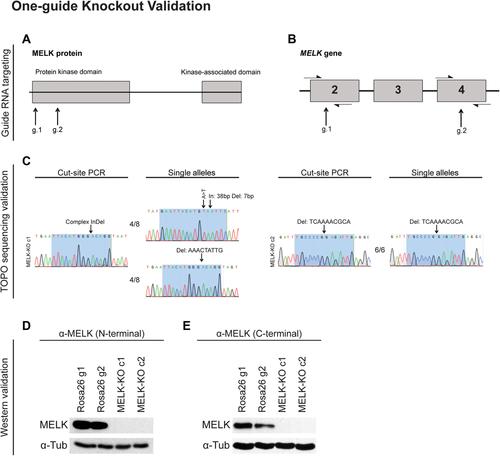{"title":"Generating Single Cell–Derived Knockout Clones in Mammalian Cells with CRISPR/Cas9","authors":"Christopher J. Giuliano, Ann Lin, Vishruth Girish, Jason M. Sheltzer","doi":"10.1002/cpmb.100","DOIUrl":null,"url":null,"abstract":"CRISPR/Cas9 technology enables the rapid generation of loss‐of‐function mutations in a targeted gene in mammalian cells. A single cell harboring those mutations can be used to establish a new cell line, thereby creating a CRISPR‐induced knockout clone. These clonal cell lines serve as crucial tools for exploring protein function, analyzing the consequences of gene loss, and investigating the specificity of biological reagents. However, the successful derivation of knockout clones can be technically challenging and may be complicated by multiple factors, including incomplete target ablation and interclonal heterogeneity. Here, we describe optimized protocols and plasmids for generating clonal knockouts in mammalian cell lines. We provide strategies for guide RNA design, CRISPR delivery, and knockout validation that facilitate the derivation of true knockout clones and are amenable to multiplexed gene targeting. These protocols will be broadly useful for researchers seeking to apply CRISPR to study gene function in mammalian cells. © 2019 The Authors.","PeriodicalId":10734,"journal":{"name":"Current Protocols in Molecular Biology","volume":"128 1","pages":""},"PeriodicalIF":0.0000,"publicationDate":"2019-07-26","publicationTypes":"Journal Article","fieldsOfStudy":null,"isOpenAccess":false,"openAccessPdf":"https://sci-hub-pdf.com/10.1002/cpmb.100","citationCount":"65","resultStr":null,"platform":"Semanticscholar","paperid":null,"PeriodicalName":"Current Protocols in Molecular Biology","FirstCategoryId":"1085","ListUrlMain":"https://onlinelibrary.wiley.com/doi/10.1002/cpmb.100","RegionNum":0,"RegionCategory":null,"ArticlePicture":[],"TitleCN":null,"AbstractTextCN":null,"PMCID":null,"EPubDate":"","PubModel":"","JCR":"Q2","JCRName":"Biochemistry, Genetics and Molecular Biology","Score":null,"Total":0}
引用次数: 65
Abstract
CRISPR/Cas9 technology enables the rapid generation of loss‐of‐function mutations in a targeted gene in mammalian cells. A single cell harboring those mutations can be used to establish a new cell line, thereby creating a CRISPR‐induced knockout clone. These clonal cell lines serve as crucial tools for exploring protein function, analyzing the consequences of gene loss, and investigating the specificity of biological reagents. However, the successful derivation of knockout clones can be technically challenging and may be complicated by multiple factors, including incomplete target ablation and interclonal heterogeneity. Here, we describe optimized protocols and plasmids for generating clonal knockouts in mammalian cell lines. We provide strategies for guide RNA design, CRISPR delivery, and knockout validation that facilitate the derivation of true knockout clones and are amenable to multiplexed gene targeting. These protocols will be broadly useful for researchers seeking to apply CRISPR to study gene function in mammalian cells. © 2019 The Authors.

利用CRISPR/Cas9在哺乳动物细胞中产生单细胞来源的敲除克隆
CRISPR/Cas9技术能够在哺乳动物细胞中的靶基因中快速产生功能缺失突变。一个携带这些突变的单细胞可以用来建立一个新的细胞系,从而产生一个crispr诱导的基因敲除克隆。这些克隆细胞系是探索蛋白质功能、分析基因丢失的后果和研究生物试剂特异性的重要工具。然而,基因敲除克隆的成功衍生在技术上具有挑战性,并且可能受到多种因素的影响,包括不完全的靶标消融和克隆间异质性。在这里,我们描述了在哺乳动物细胞系中产生克隆敲除的优化方案和质粒。我们提供了指导RNA设计、CRISPR传递和敲除验证的策略,促进了真正敲除克隆的衍生,并适用于多路基因靶向。这些协议将对寻求应用CRISPR来研究哺乳动物细胞中的基因功能的研究人员广泛有用。©2019作者。
本文章由计算机程序翻译,如有差异,请以英文原文为准。



